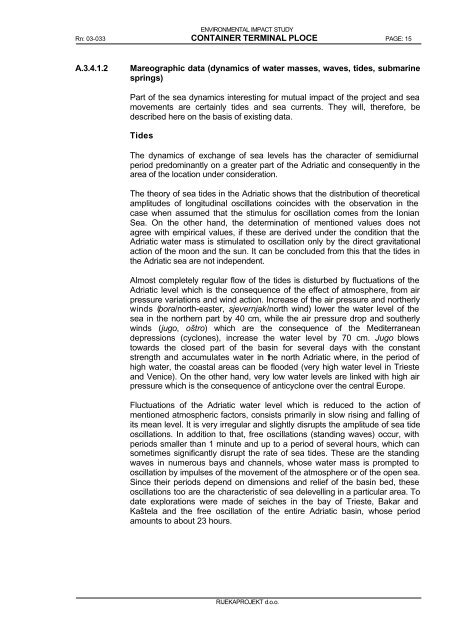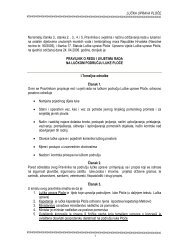HEADING PAGE - port of ploce authority * welcome
HEADING PAGE - port of ploce authority * welcome
HEADING PAGE - port of ploce authority * welcome
Create successful ePaper yourself
Turn your PDF publications into a flip-book with our unique Google optimized e-Paper software.
ENVIRONMENTAL IMPACT STUDY<br />
Rn: 03-033 CONTAINER TERMINAL PLOCE <strong>PAGE</strong>: 15<br />
A.3.4.1.2 Mareographic data (dynamics <strong>of</strong> water masses, waves, tides, submarine<br />
springs)<br />
Part <strong>of</strong> the sea dynamics interesting for mutual impact <strong>of</strong> the project and sea<br />
movements are certainly tides and sea currents. They will, therefore, be<br />
described here on the basis <strong>of</strong> existing data.<br />
Tides<br />
The dynamics <strong>of</strong> exchange <strong>of</strong> sea levels has the character <strong>of</strong> semidiurnal<br />
period predominantly on a greater part <strong>of</strong> the Adriatic and consequently in the<br />
area <strong>of</strong> the location under consideration.<br />
The theory <strong>of</strong> sea tides in the Adriatic shows that the distribution <strong>of</strong> theoretical<br />
amplitudes <strong>of</strong> longitudinal oscillations coincides with the observation in the<br />
case when assumed that the stimulus for oscillation comes from the Ionian<br />
Sea. On the other hand, the determination <strong>of</strong> mentioned values does not<br />
agree with empirical values, if these are derived under the condition that the<br />
Adriatic water mass is stimulated to oscillation only by the direct gravitational<br />
action <strong>of</strong> the moon and the sun. It can be concluded from this that the tides in<br />
the Adriatic sea are not independent.<br />
Almost completely regular flow <strong>of</strong> the tides is disturbed by fluctuations <strong>of</strong> the<br />
Adriatic level which is the consequence <strong>of</strong> the effect <strong>of</strong> atmosphere, from air<br />
pressure variations and wind action. Increase <strong>of</strong> the air pressure and northerly<br />
winds (bora/north-easter, sjevernjak/north wind) lower the water level <strong>of</strong> the<br />
sea in the northern part by 40 cm, while the air pressure drop and southerly<br />
winds (jugo, oštro) which are the consequence <strong>of</strong> the Mediterranean<br />
depressions (cyclones), increase the water level by 70 cm. Jugo blows<br />
towards the closed part <strong>of</strong> the basin for several days with the constant<br />
strength and accumulates water in the north Adriatic where, in the period <strong>of</strong><br />
high water, the coastal areas can be flooded (very high water level in Trieste<br />
and Venice). On the other hand, very low water levels are linked with high air<br />
pressure which is the consequence <strong>of</strong> anticyclone over the central Europe.<br />
Fluctuations <strong>of</strong> the Adriatic water level which is reduced to the action <strong>of</strong><br />
mentioned atmospheric factors, consists primarily in slow rising and falling <strong>of</strong><br />
its mean level. It is very irregular and slightly disrupts the amplitude <strong>of</strong> sea tide<br />
oscillations. In addition to that, free oscillations (standing waves) occur, with<br />
periods smaller than 1 minute and up to a period <strong>of</strong> several hours, which can<br />
sometimes significantly disrupt the rate <strong>of</strong> sea tides. These are the standing<br />
waves in numerous bays and channels, whose water mass is prompted to<br />
oscillation by impulses <strong>of</strong> the movement <strong>of</strong> the atmosphere or <strong>of</strong> the open sea.<br />
Since their periods depend on dimensions and relief <strong>of</strong> the basin bed, these<br />
oscillations too are the characteristic <strong>of</strong> sea delevelling in a particular area. To<br />
date explorations were made <strong>of</strong> seiches in the bay <strong>of</strong> Trieste, Bakar and<br />
Kaštela and the free oscillation <strong>of</strong> the entire Adriatic basin, whose period<br />
amounts to about 23 hours.<br />
RIJEKAPROJEKT d.o.o.



